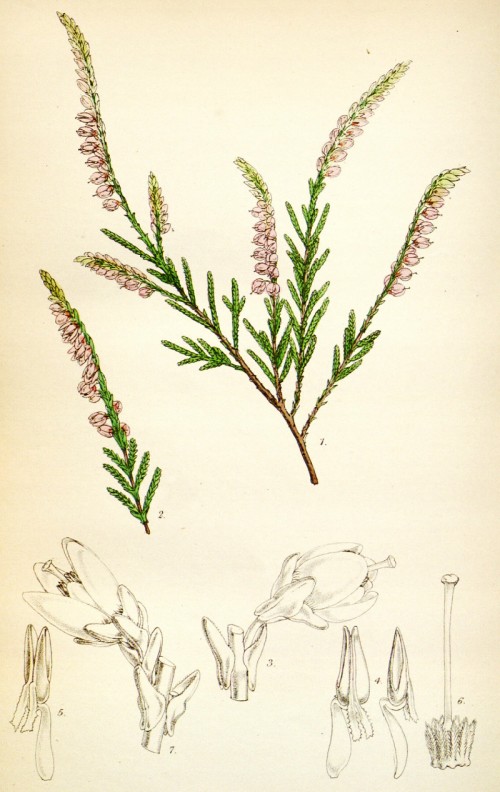Calluna vulgaris (L.) Hull - Ericaceae - ling, (common) heather, Scottish Heather, Heidekraut, Besenheide
Evergreen shrub, up to 50cm high, nativer to Central and Northern Europe, naturalized in North America; leaves small linear-lanceolate, 2-4mm long, tightly appressed to the stem; flowers small, pink to white, 4-lobed.
„Calluna vulgaris is well known as a constituent of moorlands in northern and western Europe, especially northern England, Ireland, and Scotland. The places where it is naturalized in North America are mostly coastal; inland it often is associated with railroads.“
http://www.efloras.org/florataxon.aspx?flora_id=1&taxon_id=220002166
„Heather honey is a highly valued product in moorland and heathland areas, with many beehives being moved there in late summer. Not always as valued as it is today, it was dismissed as mel improbum by Dioscurides. Heather honey has a characteristic strong taste, and an unusual texture, for it is thixotropic, being a jelly until stirred, when it becomes a syrup like other honey, but then sets again to a jelly. This makes the extraction of the honey from the comb difficult, and it is therefore often sold as comb honey.“
https://en.wikipedia.org/wiki/Calluna
„After the isolation of the carbonyl compounds by derivatisation with Girard-T reagent and gas chromatography, heather honeys showed an (S)-(+)-dehydrovomifoliol content of 56–264 mg/kg, whereas honeys from eight other floral origins contained only 0.033 to 6 mg/kg of this compound. The isolated compound was odourless, but the great difference in the (S)-(+)-dehydrovomifoliol content between heather honey and the honeys of other floral origin may offer the possibility of determining adulterations of heather honey.“
[Isolation, identification and quantitative determination of the norisoprenoid (S)-(+)-dehydrovomifoliol in honey., Häusler, M., Montag, A., Zeitschrift für Lebensmittel-Untersuchung und Forschung, Vol.189(2), 1989, 113-115]
„Found exclusively in Calluna vulgaris honeys, phenylacetic acid appears as a major aroma compound, its approximate concentration varying from 7.5 to 168 µg/g… this marker proved to be an odorant in our sniffing assessments of Calluna vulgaris honey extracts…
… it emerges that two 3,5,5-trimethylcyclohex-2-ene derivatives are predominant in Ericaceae-family honey samples, especially Calluna vulgaris samples. Two other compounds of similar structure were found exclusively in Calluna vulgaris samples: dehydrovomifoliol (4-hydroxy-4-[3-oxo-1-butenyl]-3,5,5- trimethylcyclohex-2-en-1-one) and 4-(3-oxo-1-butynyl)-3,5,5-trimethylcyclohex-2-en-1-one. The dehydrovomifoliol contents determined in this study ranged from 31 to 310 µg/g. Similar concentrations have been reported for European heather honeys (Calluna or unspecified): 70±340 µg/g 2,4-dichlorobenzaldehyde equivalent and for New Zealand Calluna vulgaris honeys: 107±185 µg/g 3-phenylprop-2-enoate equivalent. Dehydrovomifoliol, the direct precursor of aroma compounds such as vitispirans and theaspirans, is again suspected to result from abscissic acid degradation. As for 4-(3-oxo-1-butynyl)-3,5,5-trimethylcyclohex-2-en-1-one, it was detected in Calluna vulgaris honeys at concentrations ranging from 8 to 890 µg/g decane equivalent. This compound has been isolated from New Zealand Calluna honeys where its concentration was found to range from 1100 to 1400 µg/g 3-phenylprop-2-enoate equivalent. This 3,5,5-trimethylcyclohex-2-ene derivative can be considered a specific marker of Calluna vulgaris honeys.“
[Floral origin markers of heather honeys: Calluna vulgaris and Erica arborea., Guyot, C., Scheirman, V., Collin, S., Food chemistry, Vol.64(1), 1999, 3-11]
http://www.uclouvain.be/cps/ucl/doc/inbr/documents/floral.pdf

Journal of botany, British and foreign [B. Seemann], vol.4, t.53 (1866) [W.H.Fitch]
http://plantgenera.org/species.php?id_species=181213
Calluna vulgaris
© Rolf Marschner (2009),
www.botanische-spaziergaenge.at
